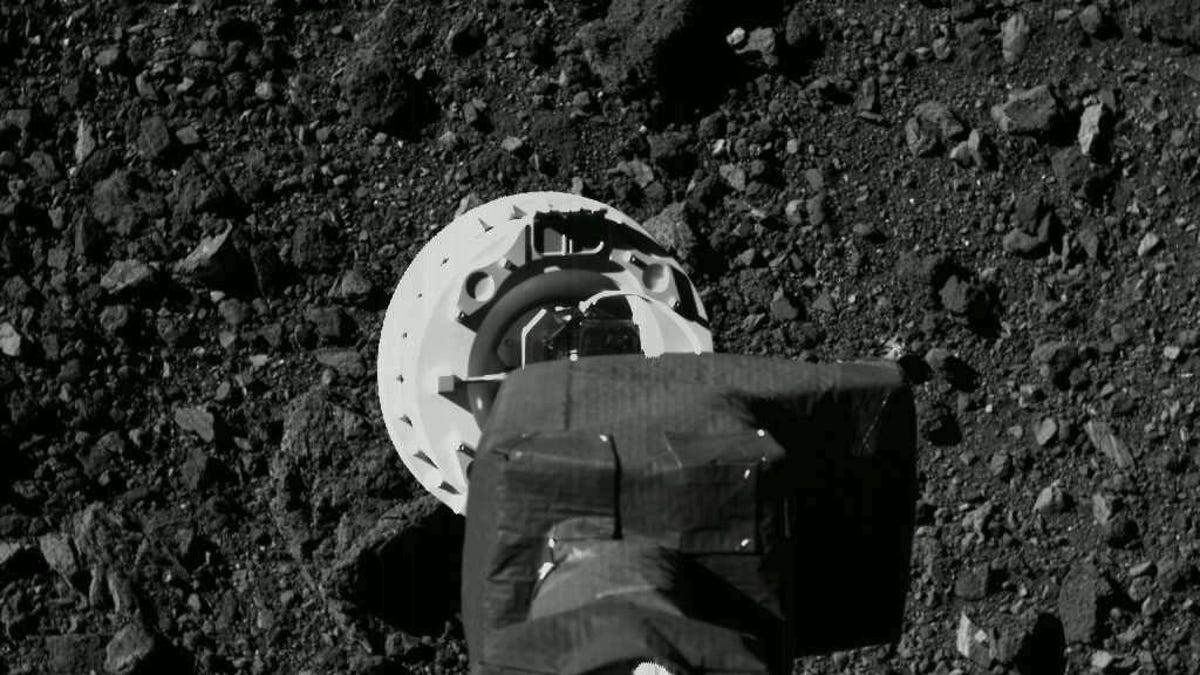NASA secures sample of asteroid Bennu to send home to Earth
The Osiris-Rex spacecraft grabbed so much space gravel its container started overflowing and the sample had to be put away early.

The spacecraft's sampling arm, called the Touch-And-Go Sample Acquisition Mechanism, over the target sample site during a dress rehearsal in April.
NASA's asteroid chaser Osiris-Rex completed a key part of its mission last week by managing to nab rocks from the surface of the potentially hazardous space rock Bennu. The sample was so abundant it started leaking into space, prompting an early stow maneuver the mission team reported on Thursday was successful.
The spacecraft traveled over 200 million miles and four years to briefly bump into Bennu, blast it with compressed gas and collect bits of its surface. On Oct. 21, the space agency shared the first batch of images from the daring operation, revealing a delicate yet explosive moment between rock and robot.
When the spacecraft's robotic sampling arm, named Touch-And-Go Sample Acquisition Mechanism, or Tagsam, touched down on Bennu, it performed what amounts to a cosmic pickpocketing maneuver. Mission planners expected that the total time of contact between the arm and asteroid would be less than 16 seconds. When preliminary data was released, it showed that the period of contact was just six seconds, with much of the sample collection happening in only the first three.
The spacecraft, which operates largely autonomously due to the 18-minute communications delay with mission control on Earth, fired a canister of gas through Tagsam that disrupted the surface of Bennu and forced a sample into the arm's collector head.
Photos taken of the head on Oct. 22 showed that so much sample was collected that some larger rocks seemed to fail to make it all the way inside, wedging a mylar flap meant to seal the container partially open, allowing some small bits of dust and pebbles to escape back out into space.
Captured by the spacecraft's SamCam camera Oct. 22, this series of three images shows the sampler head on Osiris-Rex is full of rocks and dust collected from the surface of Bennu. They also show that some of these particles are slowly escaping the sampler head.
Sample stowage was originally scheduled for Nov. 2, but NASA instead moved the multiple-day procedure up to Tuesday.
"The abundance of material we collected from Bennu made it possible to expedite our decision to stow," said Dante Lauretta, OSIRIS-REx principal investigator at the University of Arizona, in a statement.
Osiris-Rex tags a boulder
As the spacecraft approached and then spent two years orbiting and surveying Bennu, it became clear this tiny world is different from what scientists expected. The team hoped to find a number of sandy surfaces ideal for sampling, but it turns out Bennu is a rubble pile, with a rugged terrain strewn with boulders.
Around 24 hours after the operation, NASA shared the first images of the touchdown operation captured by the spacecraft. The Tagsam moves into position and its sampling head makes contact with Bennu's surface before the explosive burst of nitrogen is fired. The operation kicks up a ton of debris that flies around the acquisition arm. It's really something!
Touchdown!
Although the above GIF appears relatively fast, the operation proceeded much more delicately. The arm was lowered at around 10 centimeters per second, much slower than walking pace, when it contacted the sample site.
The team's goal is to collect about 60 grams of dust, dirt and pebbles from the surface of Bennu. It reported on Oct. 23 that it believes Osiris-Rex collected a sufficient sample and moved to begin to stow it quickly, skipping a planned sample mass measurement and canceling a braking burn to keep acceleration of the spacecraft to a minimum.
"We are working to keep up with our own success here, and my job is to safely return as large a sample of Bennu as possible," said Lauretta.
The Osiris-Rex team celebrates at the moment of touchdown.
While the procedure to gather the sample was done autonomously by the spacecraft, stowing the sample is a far slower, step-by-step process with mission control sending commands and evaluating the results before proceeding to the next step.
The mission joins Japan's Hayabusa and Hayabusa-2 missions in the annals of asteroid exploration. Hayabusa sampled and returned a tiny bit of material from asteroid Itokawa, and Hayabusa2 is in the process of returning a significant sample of space rock Ryugu.
With the sample now stowed on Osiris-Rex, the team will begin preparations for a long journey back to Earth, with a planned landing in the Utah desert in September 2023.



